Providing students with a unique opportunity to learn from experienced professionals, explore cutting-edge research, and build a global network of like-minded individuals
IEEE Engineering in Medicine and Biology Society (EMBS) is dedicated to fostering professional development for its student members. One of the primary ways that EMBS accomplishes this mission is through its student activities committee (SAC) student mentoring program.
The IEEE EMBS SAC student mentoring program is a highly successful initiative aimed at nurturing the next generation of engineers and scientists in the field of medical and biological engineering. Launched in 2021, the program has been instrumental in providing mentorship and guidance to students who are eager to pursue a career in this exciting and rapidly growing field. In this article, we will specifically review the objectives, features, and impact of the student mentoring program and present metrics that demonstrate its success.
Background
The program was first launched in 2021. The first edition was initiated with 29 mentees (with 60% male and 40% female) and 28 mentors (with 81.5% male and 18.5% female) from the first week of May to the end of October 2021. The first initiative year involved 52% undergraduate students, 16% master’s students, and 32% Ph.D. students, respectively. All mentors had at least five years of experience in their respective fields. All mentors and mentees had different technical interests from the clinical environment, industry, and academia, which had the highest number of statistics among the three major fields. With the higher demand after the 2021 initiative, 23 mentees and 10 mentors will be involved in the 2022 edition after final selection among 51 applicants for the program. In 2022, each participant, as in 2021, comes from a different educational sector from a different IEEE region, with 56.5% of males and 43.5% of females for mentees and 70% of males and 30% of females for mentors, respectively. The 2022 Student Mentoring Program involved 65.1% undergraduate students, 8.7% master’s students, 17.4% Ph.D. students, and the other 8.7%.
Goals and key features
The IEEE EMBS student mentoring program’s main feature is the formation of mentoring partnerships between students and professionals from all over the world for the purpose of sharing experiences and helping to achieve personal or academic goals. The program’s main objectives are to provide a platform for supporting IEEE EMBS student members, to promote the skills and professional development of students and young professionals in the IEEE EMB Society, to smooth the paths for their careers in BME, and to tackle the problems that arise during volunteering in their respective IEEE regions.
The IEEE EMBS student mentoring program is typically open from early March to the end of March. The recruiting information is announced through electronic mail and IEEE EMBS social media platforms. To reach the goals of the participants, the duration was set at six months. Because the program is based on BME, it is open to participants from clinical, academic, and industrial backgrounds. The main feature of the program is matching a suitable mentor and mentee based on the background and hopes of each applicant. Meeting with the right mentee and mentor is the core priority of reaching the initial goals set for the program.
In addition, the student mentoring program has a flexible structure that allows students to customize their experience based on their individual needs and goals. Mentees can choose to participate in the program for more than one edition, and they are paired with a mentor who has similar professional interests. In addition to regular virtual meetings, the program also includes various events and activities, such as summer camps and international student conferences, that provide students with hands-on learning opportunities [1].
Throughout the program, the mentee–mentor pairs were requested to meet at least two times per month to reach their initial goals during the program. Every mentee–mentor pair was also requested to submit meeting reports every time they finished their meetings. The program includes the inauguration day, bimonthly gathering meetings, and closing ceremony. During bimonthly gathering meetings, participating mentees actively presented their outcomes and the results they had achieved and performed with their respective mentors during their meetings. Based on the submitted meeting reports’ frequent numbers and their goal achievement during the program period, the mentee–mentor pairs are regarded as successfully accomplished participants, and finally, they were awarded the program’s accomplished certificate. In addition to the mentee–mentor assignment and participation, the special feature of the program is the inclusion and official assignment of program ambassadors. The student mentoring program ambassadors support the program with virtual platform logistics and by tracking and monitoring mentoring partners with their innovative ideas.
2022 Program participants
For the 2022 program, 51 applicants including mentors and mentees applied from ten IEEE regions. However, only 23 mentees and 10 mentors were chosen based on the criteria. Figure 1 presents the male and female ratios of both groups in a pie chart.
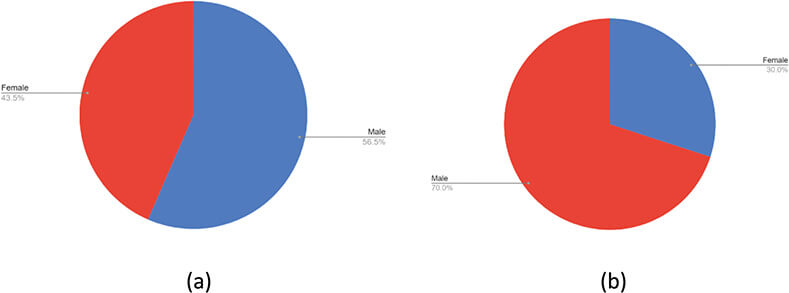
Figure 1. Gender distribution of participants in the Student Mentoring Program 2022. (a) Gender distribution of mentees. (b) Gender distribution of mentors. (Image courtesy of Nyi Nyi Tun.)
The Student Mentoring Program 2022 had participants from various regions of the world, with an equal selection ratio of IEEE regions based on application numbers. Mentees and mentors came from 15 and 10 different countries, respectively. Figure 2 illustrates the country residence statistics for both. The mentees were from six IEEE regions, while the mentors were from three, as shown in Figure 3.
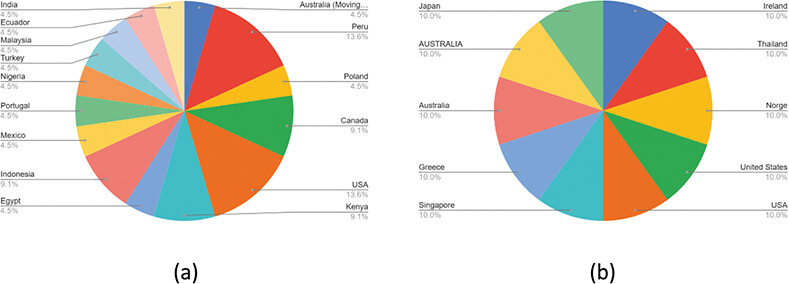
Figure 2. Residential statistics of Student Mentoring Program 2022 participants worldwide. (a) Mentees’ residence. (b) Mentors’ residence. (Image courtesy of Nyi Nyi Tun.)
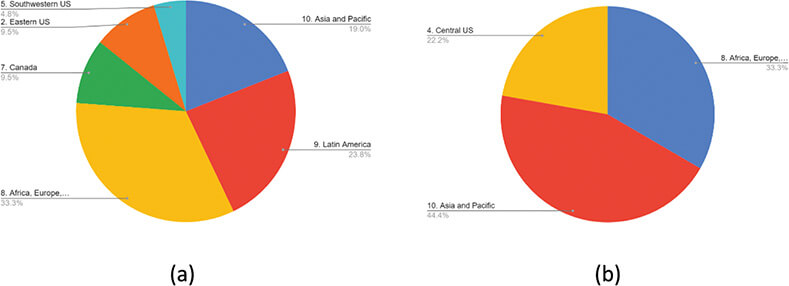
Figure 3. Regional statistics of Student Mentoring Program 2022 participants across IEEE’s 10 regions, namely Region 1: Northeastern USA, Region 2: Eastern USA, Region 3: Southeastern USA, Region 4: Central USA, Region 5: Southwestern USA, Region 6: Western USA, Region 7: Canada, Region 8: Europe, Middle East, and Africa, Region 9: Latin America, and Region 10: Asia and the Pacific; divided by (a) mentees and (b) mentors. (Image courtesy of Nyi Nyi Tun.)
Participants’ technical committee of professional interest in IEEE EMBS
Mentees and mentors in the Student Mentoring Program 2022 belong to various technical committees within IEEE EMBS. Mentees showed a particular interest in wearable biomedical sensors and systems (WBSS), biomedical and health informatics (BHI), biomedical signal processing (BSP) and analysis, biomedical imaging and image processing (BIIP), and bio robotics (BR) and biomechatronics, followed by other committees such as translational engineering and health care innovation (TEHI), bionanotechnology and bioMEMS (BNM), and neuroengineering (NE). Figure 4(a) presents detailed statistical results. Among mentors, TEHI and BHI had the highest interest, followed by other committees. The results of mentors’ technical interest are presented in Figure 4(b).
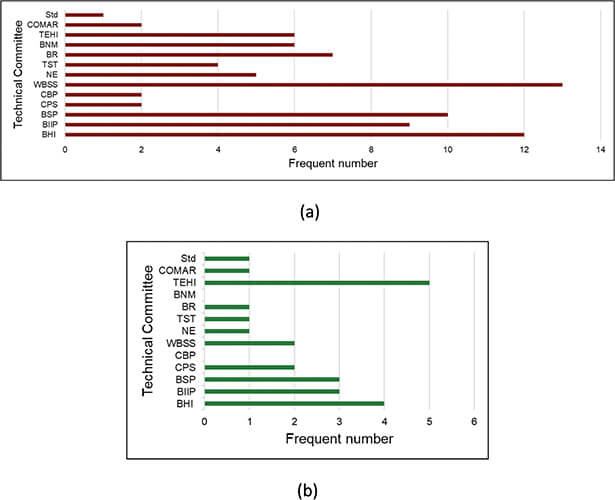
Figure 4. Technical interests related to EMBS technical committees of (a) mentees and (b) mentors, namely: BHI, BIIP, BSP, cardiopulmonary systems (CPS), computational biology and the physiome (CBP), WBSS, NE, therapeutic systems and technologies (TST), BR, BNM, TEHI, committee on man and radiation (COMAR), and standard (Std). (a) For mentees. (b) For mentors. (Image courtesy of Nyi Nyi Tun.)
Program objectives and promotion
The Student Mentoring Program 2022 focused on three main areas of interest (AOI): clinical settings, academic institutions, and industries, in that order. The statistical results revealed that most of the mentees and mentors were interested in academia and industry. Since the majority of mentees had an academic background, their highest AOI was academics, while mentors showed a greater interest in industry, as depicted in Figure 5(a) and (b).
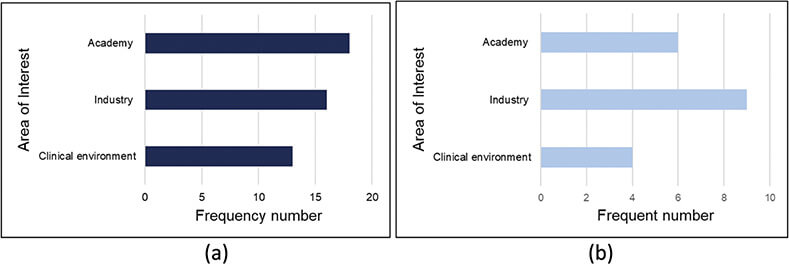
Figure 5. Statistical results of AOI. (a) For mentees. (b) For mentors. (Image courtesy of Nyi Nyi Tun.)
To achieve the program’s initial objectives, the most effective mentoring fields for mentees were taken into consideration. The major mentoring areas for the Student Mentoring Program 2022 included technical, educational, career, leadership, volunteering, and personal development.
Promoting the program to students and young professionals within and outside the IEEE society was crucial, and various platforms were used for its promotion. The SAC public relations team (PR team) designed posters and flyers, which were shared across all IEEE EMBS social media platforms. The program’s recruitment information was also sent via email to all EMBS students in the global network. However, promoting the program outside of the IEEE society remains a challenge for future editions.
The program was conducted over six months, primarily through four major meetings, as illustrated in Figure 6. The program included an inauguration day to welcome mentees and mentors, two bimonthly gathering meetings, and a final closing ceremony. The bimonthly gatherings were held for mentees and mentors to evaluate the progress of all matched pairs.
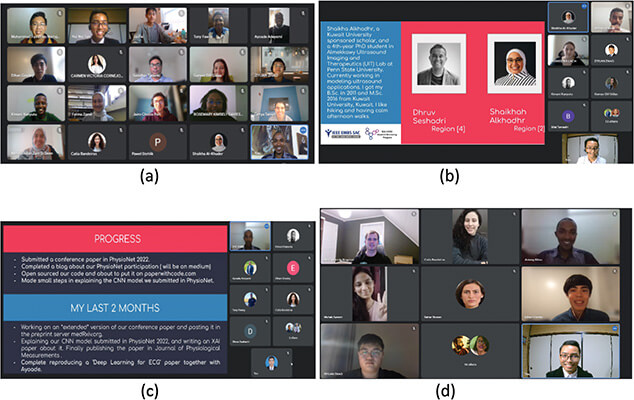
Figure 6. Images from the Student Mentoring Program 2022 meetings organized by Dr. Nyi Nyi Tun. (a) Welcome event. (b) First bi-monthly meeting. (c) Second bi-monthly meeting. (d) Closing ceremony of Student Mentoring Program 2022. (Photos courtesy of Nyi Nyi Tun and Antony Gitau.)
Program impact and result
The Student Mentoring Program 2022 has been highly impactful over the past two years due to the successful mentee–mentor relationships. The program’s impact is measured both quantitatively and qualitatively. The quantitative impact is evaluated based on various metrics, such as an increase in student research, advanced degrees, feedback from mentors and mentees, and the desire to participate in future programs. On the other hand, the qualitative impact is assessed by the number of publications in high-impact scientific journals, research papers, and conferences that the mentee–mentor pairs attended.
The results of the Student Mentoring Program 2022 were positive overall. Out of the 23 mentees, 18 successfully completed the program under the guidance of their respective mentors. The other five mentees voluntarily quit the program. Therefore, it can be concluded that nearly 85.7% of mentee–mentor pairs achieved their initial goals. In addition, a short survey was conducted among mentees and mentors to clearly outline the program’s outcomes. The survey results revealed that 100% of participants found suitable mentee–mentor pairs and 85.7% reached their initial goals. Furthermore, 92.9% of participants improved their professional and leadership skills and wanted to join future programs. The survey results were satisfactory, although the program needs more publicity in the future.
One of the most significant quality impacts of the Student Mentoring Program 2022 is the publication of papers in international journals by several mentee–mentor pairs within the six-month duration of the program. The articles [2], [3] demonstrate this achievement. The program’s primary goal of increasing student research has been successfully met, indicating that the Student Mentoring Program 2022 has fulfilled the expectations of both mentees and mentors.
The IEEE EMBS student mentoring program is an important tool for fostering the professional growth and development of student members of the IEEE EMBS. Through its focus on pairing student members with experienced professionals, the program is effectively preparing the next generation of leaders in the field. With its flexible structure, personalized approach, and focus on hands-on learning opportunities, the program has provided students with a valuable resource for building the skills and knowledge they need to succeed in this exciting and rapidly growing field. The EMBS SAC is committed to continuing to improve and expand the program, and we encourage all EMBS members to consider participating in the program as a mentee or mentor.
We invite all interested EMBS members to reach out to sac@embs.org to learn more about the student mentoring program and find out how they can get involved. Together, we can ensure that the next generation of leaders in the fields of engineering, medicine, and biology is well prepared to meet the challenges and opportunities of the future.
References
- A. L. Cakici, B. Aleman and E. Grooby, “IEEE EMBS International Student Conferences—Insights from 2022 editions,” IEEE Pulse, vol. 13, no. 6, pp. 29–32, Nov./Dec. 2022, doi: 10.1109/MPULS.2022.3227855.
- B.-J. Singstad and B. Tavashi, “Using deep convolutional neural networks to predict patients’ age based on ECGs from an independent test cohort,” medRxiv, 2022. [Online]. Available: https://www.medrxiv.org/content/early/2022/10/06/2022.10.03.22280640
- B.-J. Singstad et al., “Phonocardiogram classification using 1-dimensional inception time convolutional neural networks,” in Proc. Comput. Cardiol. (CinC), 2022, pp. 1–4, doi: 10.13140/RG.2.2.22956.1344.



